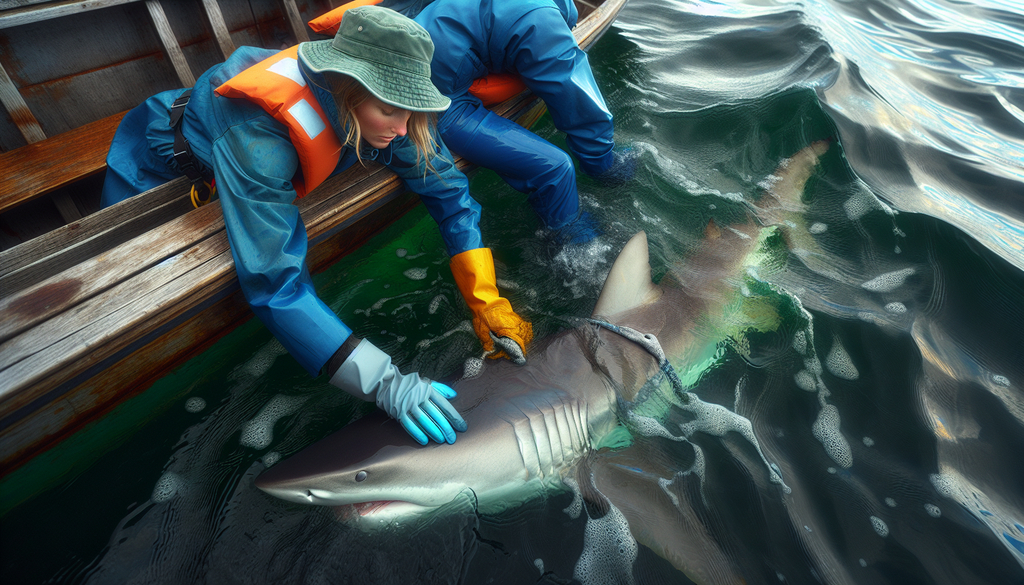Oregon State researchers record two shark species in Puget Sound for the first time

CORVALLIS, Oregon – In a groundbreaking discovery, researchers from Oregon State University have confirmed the presence of two distinct shark species in Puget Sound for the first time, with one being critically endangered.
The documented species—broadnose sevengill shark and the endangered soupfin shark—have been found in this vital section of the Salish Sea, a body of water recognized for its economic, cultural, and ecological significance, according to biologists from OSU’s Big Fish Lab.
The Salish Sea spans northwestern Washington and extends to Vancouver Island in British Columbia, covering 6,500 square miles. The sharks were spotted near Olympia, south of Puget Sound, marking the southernmost region of the waterway.
Taylor Chapple, assistant professor at Oregon State’s College of Agricultural Sciences, along with graduate students Jessica Schulte and Ethan Personius, documented these findings in research papers published in the journal *Frontiers in Marine Science*.
The researchers partnered with NOAA’s National Marine Fisheries Service and the Washington Department of Fish and Wildlife to confirm that the broadnose sevengill, an apex predator that can grow up to 10 feet, has established presence in the highly urbanized environment of South Puget Sound.
“Understanding the sevengill’s adaptation to this new habitat is key for unraveling the intricacies of the Salish Sea’s ecosystem,” said Schulte, who led the broadnose sevengill study. “It also accentuates the critical need for continual monitoring, particularly in relation to species of conservation concern, like salmon.”
Broadnose sevengill sharks—distinguished by their seven gill slits, two more than most sharks—feed on a range of animals: from fish (including rays and other sharks) to crustaceans and marine mammals. They inhabit temperate waters globally, with a range encompassing southern Alaska to Baja California along the West Coast of North America.
Before 2021, only one visual confirmation of a sevengill shark in the Salish Sea had been made, near the Canadian border at Point Roberts in Washington. However, anecdotal reports indicate multiple sevengills were caught in the southern part of Puget Sound in August 2021.
Over 10 days of field research conducted in 2022 and 2023, the team managed to catch nine sevengill sharks, located more than 190 miles beyond their previously noted range. Notably, all but one were male; the largest measuring just under 7 feet, while the sole female reached around 4 feet 6 inches.
“Ongoing research into sevengills along the coasts of Oregon and Washington will deepen our grasp of its role within these marine environments,” Schulte added.
The soupfin shark study, led by Personius, provides important insights as well. This species, the largest in the hound shark family, grows up to 6 ½ feet and is named for its prevalent use in shark fin soup.
“Soupfin sharks were heavily fished in the 1930s and 1940s, primarily for their livers, which are rich in vitamin A,” Personius explained. “Despite lower fishing pressures nowadays, they have struggled to recover and are up for review under the Endangered Species Act.”
Like sevengill sharks, soupfin sharks inhabit temperate waters worldwide and are top predators. Their diet includes cephalopods and various fish species. Known for their endurance, soupfin sharks can migrate over 1,000 miles.
As part of the broader field research, the team also captured a soupfin shark, a male measuring just over 5 feet in length.
“The Salish Sea has seen significant shifts in species composition and abundance—largely attributed to industrialization and habitat degradation,” Personius said. “Soupfin sharks appearing here could be linked to broader environmental changes like climate shifts and food availability.”
Following the 2014-2015 marine heatwave known as “The Blob,” anchovies, once rare in the Salish Sea, surged in population. Soupfin sharks, well-known for preying on anchovies, may have been drawn to the area by this change in prey abundance.
Graduate student Maddie English co-authored research on the soupfin shark, together with NOAA Marine Fisheries Service experts and the Washington Department of Fish and Wildlife. The sevengill shark study also benefited from the contributions of research associate Alexandra McInturf.
Journal
Frontiers in Marine Science
DOI
10.3389/fmars.2024.1430962
Method of Research
Observational study
Subject of Research
Animals
Article Title
Observation of the Critically Endangered Soupfin Shark (Galeorhinus galeus) in the Changing Salish Sea
Article Publication Date
17-Jul-2024
COI Statement
The authors declare no conflicts of interest, either commercial or financial, that could be perceived as influencing the research.


